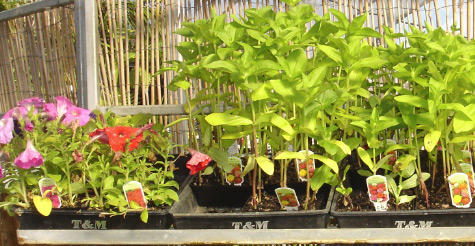The case for an optimum level of wastage in garden centres and ways to minimise stock loss
There are a number of ways in which stock shrinkage / loss occurs. Most surveys show the following to be the pattern:
Loss due to deterioration |
78% |
|---|---|
| Shoplifting | 6% |
| Staff theft | 10% |
| Short deliveries | 3% |
| Clerical errors | 3% |
How do we minimise loss due to deterioration?
Maintenance
It is obvious and well known that plants must be in a location with sufficient light and shelter according to their needs, especially if they are slow moving lines.
Correct watering is crucial. If plants are under-watered or over-watered, they will deteriorate. Whilst sprinklers are generally satisfactory for shrubs there can still be problems. Bottom up capillary watering certainly gives more control. Hand watering is usually satisfactory for bedding plants and many colour plants.
Buying
Buying more than necessary (in order to get a better deal) often leads to high losses.
Slow moving low demand lines should be purchased in less quantity more often.
Fast moving high demand products on the other hand can and should be purchased in quantity – BUT, in order to minimise waste, they need to be merchandised aggressively in a hot spot with in a sign to sell them through. See ‘promotion’ below.
Promotion
Promotion in store – high volume well merchandised and signed in a hot spot will move high volumes. This strategy may lead to a higher wastage but it is acceptable, as long as it does not exceed 2.0% of sales.

Early removal and disposal of deteriorating plants
A key tool in managing wastage is to remove deteriorating plants sooner rather than later. Most stores have a clearance bin and move deteriorating plants to the clearance bin and sell for half price. This is a sound policy providing plants are moved there at the very first sign or just before deterioration begins, not after when the plant looks sad. Good operators even move end of line plants to this clearance area even if they are in perfect order.
The clearance bin should be reviewed every week and any plants that have deteriorated to a point where a reasonable person would not pay half price, should be thrown out. Do not leave plants there until they have a birthday.
Plant hospitals, where plants are cut back, fertilised and sometimes potted on, have proven to add to costs because it is maintenance that is an inefficient use of staff time and costs can never be recovered.

What level should throw out wastage be?
Many would think it should be as low as possible, even zero. The benchmarking we do for many garden centres has turned up an interesting observation:
- The average level of throw out wastage is 0.7% of sales (cost value of throw outs as a % of sales at retail).
- The most pro-active and highest achieving garden centres (growth in sales and profits) have a wastage of 1 – 2% of sales.
- The lowest achieving garden centres have a wastage of 0.3 – 0.5% of sales.
This suggests that high-achieving garden centres are bolder and more pro-active with buying and promotion but have more wastage as a consequence – although still acceptable relative to the growth and profit achieved.
Garden centres with a low wastage tend to be low achievers in terms of growth in sales and profits, because they are very conservative buyers and less pro-active with promotions.
- Bill Brett
